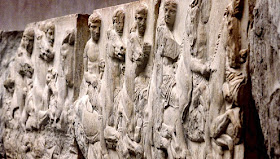The Parthenon Marbles, also known as the Elgin Marbles, is a collection of classical Greek marble sculptures, inscriptions and architectural members that originally were part of the Parthenon and other buildings on the Acropolis of Athens. Thomas Bruce, the 7th Earl of Elgin obtained a controversial permit from the Ottoman authorities to remove pieces from the Parthenon while serving as the British ambassador to the Ottoman Empire from 1799 to 1803.
The Parthenon Marbles acquired by Elgin include seventeen figures from the statuary from the east and west pediments of the Parthenon, fifteen (of the original 92) of the metope panels depicting battles between the Lapiths and the Centaurs, as well as 247 feet (75 meters) of the original 524 feet (160 meters) of the Parthenon Frieze which decorated the horizontal course set above the interior architrave of the temple. As such, they represent more than half of what now remains of the surviving sculptural decoration of the Parthenon. Elgin's acquisitions also included objects from other buildings on the Athenian Acropolis: a Caryatid from Erechtheum; four slabs from the parapet frieze of the Temple of Athena Nike; and a number of other architectural fragments of the Parthenon, Propylaia, Erechtheum, the Temple of Athena Nike, and the Treasury of Atreus.
Ekathimerini reports that 37 percent of respondents said that the ancient sculptures should be given back to their country of origin. Twenty-three percent said the marbles should remain at the British Museum in London. Meanwhile, 32 percent said they were indifferent about the issue and 7 percent said they did not know. When asked about why Britain should give up the artefacts, most of those who argued for their return said that they 'are one work of art and they should be reunited along with the rest of the Parthenon sculptures in Greece.'
The results come in the wake of more heartfelt columns and testimonials in mainstream media outlets. The Guardian, for example, has posted an account by Helena Smith entitled 'As a Briton, I hang my head in shame. We must return the Parthenon marbles'. To quote from it:
It's a powerful statement, and as with most of the article, I fully agree. As the article mentions, it's not even about ownership anymore, it's about the fact that these stones belong home, in Attica, and to keep them away from there is unethical, and it needs to end. Thankfully, more an more people are starting to agree.
 |
| The Parthenon Sculptures as seen on display at the
British Museum in London on June 5, 2000 [Credit: Reuters] |
The Parthenon Marbles acquired by Elgin include seventeen figures from the statuary from the east and west pediments of the Parthenon, fifteen (of the original 92) of the metope panels depicting battles between the Lapiths and the Centaurs, as well as 247 feet (75 meters) of the original 524 feet (160 meters) of the Parthenon Frieze which decorated the horizontal course set above the interior architrave of the temple. As such, they represent more than half of what now remains of the surviving sculptural decoration of the Parthenon. Elgin's acquisitions also included objects from other buildings on the Athenian Acropolis: a Caryatid from Erechtheum; four slabs from the parapet frieze of the Temple of Athena Nike; and a number of other architectural fragments of the Parthenon, Propylaia, Erechtheum, the Temple of Athena Nike, and the Treasury of Atreus.
Ekathimerini reports that 37 percent of respondents said that the ancient sculptures should be given back to their country of origin. Twenty-three percent said the marbles should remain at the British Museum in London. Meanwhile, 32 percent said they were indifferent about the issue and 7 percent said they did not know. When asked about why Britain should give up the artefacts, most of those who argued for their return said that they 'are one work of art and they should be reunited along with the rest of the Parthenon sculptures in Greece.'
The results come in the wake of more heartfelt columns and testimonials in mainstream media outlets. The Guardian, for example, has posted an account by Helena Smith entitled 'As a Briton, I hang my head in shame. We must return the Parthenon marbles'. To quote from it:
"As a Briton, I hang my head in shame but take heart in what the poet Titos Patrikios, an old friend, calls Greece’s “unbeatable weapon”; the common sense of ordinary Britons who for almost two decades have overwhelmingly endorsed repatriation in successive opinion polls. It was another poet, Yannis Ritsos, who summed up the marbles’ predicament best. “These stones don’t feel at ease with less sky,” he wrote. They needed the luminosity of Attica to be appreciated most. More than anything, the argument for the marbles’ return is as much about scholarship as it is about aesthetics or ethics. To go on advocating that Phidias’s masterpieces are better off in London is, in essence, to argue that the finest carvings of classical times are better amputated and broken up."
It's a powerful statement, and as with most of the article, I fully agree. As the article mentions, it's not even about ownership anymore, it's about the fact that these stones belong home, in Attica, and to keep them away from there is unethical, and it needs to end. Thankfully, more an more people are starting to agree.
No comments:
Post a Comment